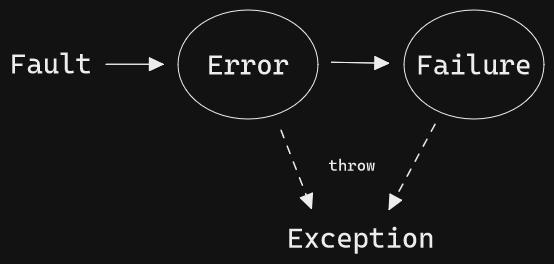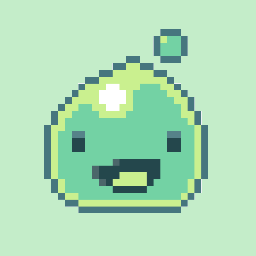Notes: Exception Handling
Introduction
Most of the content is from the blog by Teddy, who is specialized in exception handling. It’s interpreted with my own understanding, and I think it should not be any form of golden rules.
Taxonomy

Fault
- Design fault (e.g. divided by zero, null pointer)
- Component fault (e.g. storage full)
Error
A state caused by fault. If the fault is not handled properly, it would lead to failure state.
Failure
A state caused by not handling error state properly, which indicates that the system departs from its specification.
For example, when we do transactions on databases, some of them may fail (fault occurs). If we can fix the error (state) by rolling back, the system failure (state) won’t occur.
Exception
Representation of error and failure state.
Robustness Levels
| Goal level | Name | State | Service |
|---|---|---|---|
| G0 | Undefined | Unknown | Unknown |
| G1 | Error-reporting | Incorrect | Failed explicitly |
| G2 | State-recovery | Correct | Failed explicitly |
| G3 | Behavior-recovery | Correct | Delivered |
Suggestion
- Required to be G1
- If it’s rather easy to achieve G2, go for it (e.g. database transactions, prevent memory leak)
- If it’s really important, then work hard for G3
Bad Smells
Return code
public fun withdraw(amount: Int): Int {
if (amount > balance) {
return -1
}
// ...
}
- Hard to maintain when putting regular logic and exception handling together
- Developers may forget to check the return code
Ignored exception
try {
val file = File("data.txt")
} catch (e: FileNotFoundException) {
// ???
}
Unprotected main program
- Program will be terminated unexpectedly, which is a bad UX
Dummy handler
try {
val file = File("data.txt")
} catch (e: FileNotFoundException) {
Log.e(e)
}
- Hard to debug
Nested try statement
try {
val file = File("data.txt")
} catch (e: FileNotFoundException) {
// ...
} finally {
try {
// ...
} catch (e: Throwable) {
// ...
}
}
- Hard to maintain
- Replace the nested one with function
- Prevent putting exception handling and regular logic together
Careless cleanup
- Cleanup in
try
var stream: OutputStream? = null
try {
stream = File("data.txt").outputStream()
// ...
stream.close() // Won't be executed if exception occurred
} catch (e: Throwable) {
// ...
}
- Cleanup in
catch
var stream: OutputStream? = null
try {
stream = File("data.txt").outputStream()
// ...
} catch (e: Throwable) {
stream?.close() // Won't be executed if NO exception occurred
}
- Consecutive cleanup
var stream1: OutputStream? = null
var stream2: OutputStream? = null
try {
stream1 = File("data1.txt").outputStream()
stream2 = File("data2.txt").outputStream()
// ...
} finally {
stream1?.close()
stream2?.close() // Won't be executed if exception occurred when stream1.close()
}
In Kotlin, we may use the extension
useinstead:
try {
File("data.txt").outputStream().use { outputStream ->
// ...
}
} catch (e: Throwable) {
// ...
}
Context
Exception context
- Method name
- Stack trace
- Line number
Object context
- State of the object
Local context
- Method parameters
- Local variables
Application context
Sometimes the exception can’t be handled properly right at where it happens, so we may need to collect the context (exception, object, and local context) and throw again by chained exceptions.
// Constructor of Exception.java
public Exception(String message, Throwable cause)
class ExceptionTest {
@Test
fun `chained exceptions`() {
try {
val obj = ExceptionObject()
obj.methodA()
} catch (e: Throwable) {
e.printStackTrace()
}
}
private class ExceptionObject {
fun methodA() {
try {
methodB()
} catch (e: Throwable) {
throw Exception("Exception in A!", e)
}
}
private fun methodB() {
throw Exception("Exception in B!")
}
}
}

Exceptions in Kotlin
These definitions only apply to Kotlin.
Throwable
Base class for all exceptions and errors.
Exception
Subclass of Throwable that indicates conditions that a reasonable application might need to catch and handle, and try to recover the service back to normal. (e.g. FileNotFoundException, IOException)
Checked exception in Java (removed in Kotlin)
In Kotlin, we can still use this feature by annotation
@Throws.
Appendable append(CharSequence csq) throws IOException;
try {
log.append(message)
} catch (IOException e) {
// Must be safe
}
- Checked exception: All exceptions except for subclass of
RuntimeException - Unchecked exception: Subclass of
RuntimeException
Error
Subclass of Throwable that indicates serious problems that a reasonable application should NOT try to catch, because it’s usually not possible to recover from them. (e.g. OutOfMemoryError, StackOverflowError)
Best Practices
Do NOT handle design faults
Design faults should be fixed, not handled, such as
- Divided by zero
- Null pointer
- Index out-of-bound
Do NOT declare unnecessary exceptions
Declare a new exception only when it should be handled differently with existing cases.
Name exceptions by what problem it is
For example, it’s a repository doing bank transactions:
class BankAccountRepository {
fun withdraw(int amount) {
if (amount > balance) {
// throw exception
}
}
}
This exception may be named:
- ❌
BankAccountException(named by object) - ❌
WithdrawException(named by function) - ✅
NotEnoughBalanceException(named by problem) - 🤔
TransactionException(if all transaction exceptions should be handled in the same way)
Translate low-level exceptions to high-level ones
For example, we have a function which throws IOException:
fun saveProperty() {
throw IOException()
}
In somewhere high-level, we handle the exception:
try {
saveProperty()
} catch (e: IOException) {
// Handle the exception
}
Someday we decide to change the implementation to some database which throws SQLException:
fun saveProperty() {
throw SQLException() // Changed!
}
Then high-level functions will not catch the new exception.
Instead, we can consider to declare a new exception to wrap the low-level exception, e.g. PropertyManipulationException.
Do NOT rethrow all the way
If rethrowing the exception without handling just for logging from the outside, just throw once and catch with wrapped main.
Case Studies
Data not found in database
- Return null → It’s reasonable to not found the data
- Throw exception (e.g.
DataNotFoundException) → It should always be found - Return null object → For some special requirement
Exceptions in observers
Do NOT throw exceptions in observers, if the subjects are not handling exceptions and terminate the notification; otherwise, the subject would crash, affecting other observers. It depends on design.
Reference
- Exceptions - Kotlin
- 笑談軟體工程:例外處理設計的逆襲
- Fault、Error、Failure、Exception
- 敏捷式例外處理設計的第一步:決定例外處理等級
- 例外處理壞味道(上)
- 例外處理壞味道(下)
- 例外處理的四種Context(1):Exception Context
- 例外處理的四種Context(2):Object Context與Local Context
- 例外處理的四種Context(3):Application Context
- 例外處理實務做法(1):Toward Exception-Handling Best Practices
- 找不到資料要傳回Null還是丟出Exception?
- 例外處理和設計模式

Leave a Comment